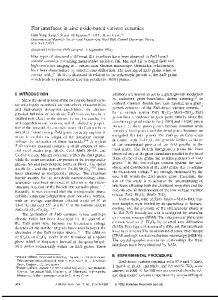Interfaces in Structural Ceramics
- PDF / 14,685,663 Bytes
- 9 Pages / 604.8 x 806.4 pts Page_size
- 57 Downloads / 340 Views
TIN/OCTOBER1990
compacts at reasonable processing températures and also to permit control of the grain size of the final material. For many ceramic materials, particularly the primarily covalently bonded nitrogen ceramics, the solid-state process is often aided by the introduction of a liquid phase. The nature and distribution of this phase may produce corresponding changes in the properties of the ceramic. Since the morphology of the grains and the structure and chemistry of the interfaces are ail important, it is advantageous to be able to characterize both features simultaneously; this can be accomplished using transmission électron microscopy (TEM). The study of interfaces in structural ceramics is far less developed than for interfaces in metals, and it would be désirable to be able to carry over as many ideas as possible. The problem is identifying which features are common to ail materials and which are spécifie to covalent/ionic materials. This review will illustrate some of the features that appear to be spécial to ceramics. Structure and Bonding The strongest solids are composed of the éléments Be, B, C, N, O, Mg, Al, and Si. Examples of materials beginning to find structural applications include SiC, Si3N4, the SiAlON's, B4C, A1203, Zr0 2 with additions of MgO or Y203. Combinations of thèse materials such as A1203 with Zr0 2 additions are producing improvements in toughness over singlephase materials. By combining différent materials having différent properties, composite materials can be formed — the particular property of interest can be tailored by choice of the matrix and/ or insert. A material's strength can be directly correlated to its structure and the nature of the interatomic bonding. A high breaking strength, crmax requires a high Young's modulus, a large surface energy, y, and a small séparation between the atoms.1
The interrelation between thèse factors can be expressed as
V flo where E is Young's modules and a0 is the equilibrium séparation of the atomic planes. Covalently bonded and metallic crystals hâve the highest values of amax, whereas ionic crystals tend to hâve a lower value in many, if not ail, directions.1 In addition to possessing a high value of o-max, a high value for Tmnx (the shear stress) is also an idéal requirement for strong solids. Such values are found in solids in which the interatomic forces are directional in nature — covalently bonded materials and materials with strongly polarized ionic bonds. Covalently bonded materials are stiffest when they are composed of small atoms linked by short bonds, so that there are many bonds per unit volume. The elastic modulus of an ionic crystal increases directly as the product of the valencies of the ions, and inversely as the fourth power of the interionic distance. Thus, an ideally strong ionic solid will contain small atoms of high charge. The éléments possessing the requisite properties hâve been listed above; the strongest materials always contain one of thèse éléments and frequently only thèse. Properties and Applications A
Data Loading...










